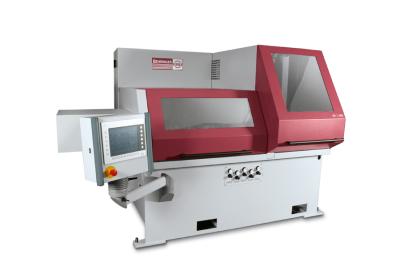
Behringer Saws Inc. has added the VA-L 500 to its line of circular cold saws. Behringer Eisele GmbH designed the VA-L 500 sawing system specifically for production cutting of aluminum and nonferrous materials. With a frequency-controlled main drive system and adjustable cutting speeds, the VA-L 500 can saw the full range of aluminum alloys and other nonferrous materials in solids, thin-walled pipe and profiles highly efficiently.
The VA-L 500 saw comes standard with a 32 H.P. frequency-controlled drive motor with 800-3,400 rpm speed range and a servo-driven downfeed with an adjustable rate from .39”/sec to 19.6”/sec, to ensure the fastest possible cut times. The fully automatic high-performance circular cold saw has a cutting range of 6.0” (152 mm) for round materials or 6” x 6” (152x152 mm) for square materials at 90° using a carbide-tipped circular saw blade with a diameter of 19.6” (500 mm). With a robust overall design with the latest drive technology in the feed axis and stiff saw blade guiding, the VA-L 500 reportedly ensures optimal, low-vibration sawing with excellent cutting performance and surface finish quality.
“Our VA-L series features a heavy-duty design, state-of-the-art drive technology used in the feed axis and main drive system, and an extremely rigid, ultra-precise saw spindle bearing,” commented Joe Suydam, inside sales and marketing manager at Behringer Saws. “The result is an optimized, low-vibration cutting process that provides maximum cutting output and excellent surface finish quality in both solid materials as well as in pipe and profiles with sophisticated cross-sectional geometry.”
An automatic blade/material separation feature guarantees a free return of the saw blade, reducing blade damage and resulting in high quality material finishes. An NC gripper feed unit, driven by a servomotor, ball screw spindle and encoder with a single stroke capacity of 39.3”, ensures quick and precise movement of material.
A Lift-and-shift device for material feed, a standard feature of the VA-L 500 saw, ensures the material is lifted slightly over the material support table, enabling the material to be “freely” fed without touching the material table and clamping jaws, eliminating damage to the surface of the material. Furthermore, to reduce buildup of chips and scratching of material, a blowing device rapidly removes chips from the clamping area, providing a clean material clamping surface area and unobstructed material flow for increased service life. Also standard on the VA-L 500 is a material disposal/discharge unit featuring a support plate and a sorting chute that moves trim/remnants and parts into two separate areas.
Contact Details
Related Glossary Terms
- alloys
alloys
Substances having metallic properties and being composed of two or more chemical elements of which at least one is a metal.
- aluminum alloys
aluminum alloys
Aluminum containing specified quantities of alloying elements added to obtain the necessary mechanical and physical properties. Aluminum alloys are divided into two categories: wrought compositions and casting compositions. Some compositions may contain up to 10 alloying elements, but only one or two are the main alloying elements, such as copper, manganese, silicon, magnesium, zinc or tin.
- circular saw
circular saw
Cutoff machine utilizing a circular blade with serrated teeth. See saw, sawing machine.
- feed
feed
Rate of change of position of the tool as a whole, relative to the workpiece while cutting.
- numerical control ( NC)
numerical control ( NC)
Any controlled equipment that allows an operator to program its movement by entering a series of coded numbers and symbols. See CNC, computer numerical control; DNC, direct numerical control.
- sawing
sawing
Machining operation in which a powered machine, usually equipped with a blade having milled or ground teeth, is used to part material (cutoff) or give it a new shape (contour bandsawing, band machining). Four basic types of sawing operations are: hacksawing (power or manual operation in which the blade moves back and forth through the work, cutting on one of the strokes); cold or circular sawing (a rotating, circular, toothed blade parts the material much as a workshop table saw or radial-arm saw cuts wood); bandsawing (a flexible, toothed blade rides on wheels under tension and is guided through the work); and abrasive sawing (abrasive points attached to a fiber or metal backing part stock, could be considered a grinding operation).
- sawing machine ( saw)
sawing machine ( saw)
Machine designed to use a serrated-tooth blade to cut metal or other material. Comes in a wide variety of styles but takes one of four basic forms: hacksaw (a simple, rugged machine that uses a reciprocating motion to part metal or other material); cold or circular saw (powers a circular blade that cuts structural materials); bandsaw (runs an endless band; the two basic types are cutoff and contour band machines, which cut intricate contours and shapes); and abrasive cutoff saw (similar in appearance to the cold saw, but uses an abrasive disc that rotates at high speeds rather than a blade with serrated teeth).
